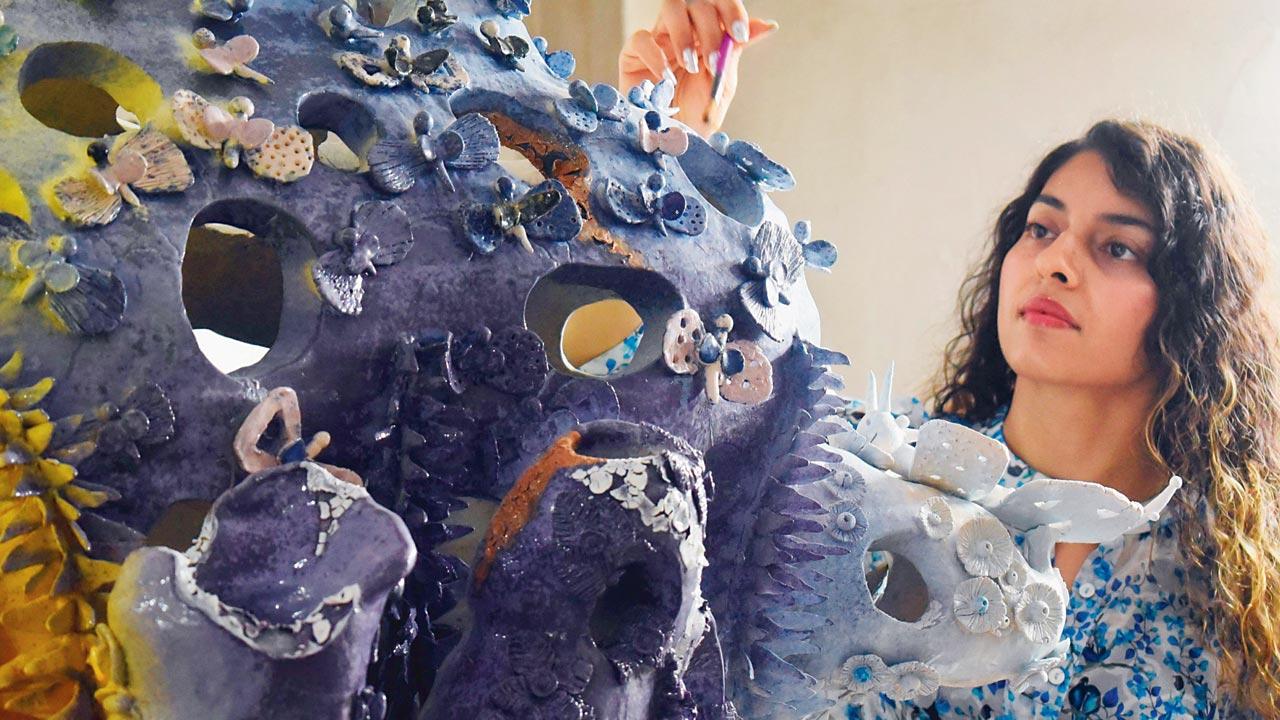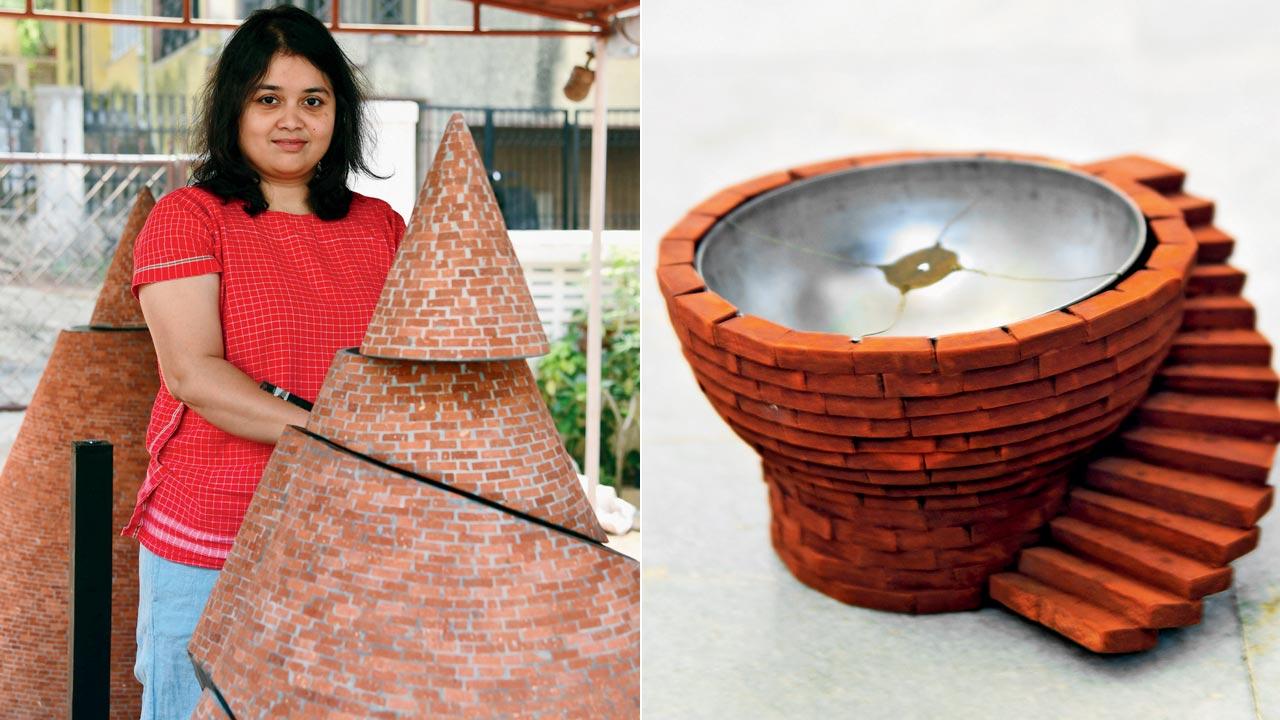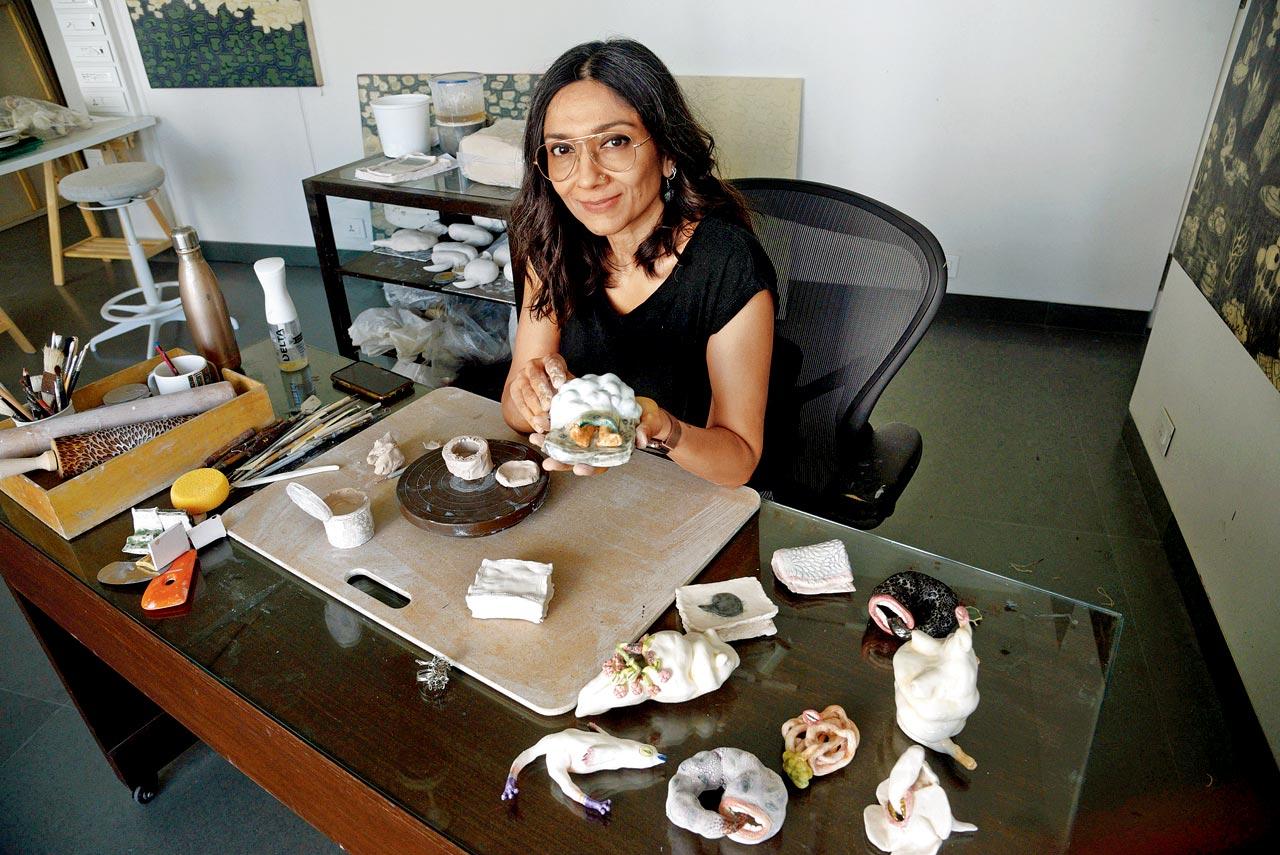As the Indian Ceramics Triennale approaches, we speak to three female artists leading the way, whose kilns burn in Mumbai

The humour that characterises painter Dhruvi Acharya’s style is even more palpable in her sculptures. Pic/Pradeep Dhivar
Across their varying styles and approaches, the unlikely thing that ties three female ceramic artists—Teja Gavankar, Dhruvi Acharya and Vinita Mungi—together is their sense of humour. In a conversation about her decision to make Mumbai her professional base, Gavankar brings to our notice the bricks she works with, fashioning entire sculptures out of them. Smaller than the bricks normally used in construction, these miniature cuboids are a product of working in a 10x10 feet studio, in a city where pocket-sized homes are the norm.
“At first, I wondered how I could pursue my style in Mumbai, because it wasn’t possible to store bricks in my Borivli studio. So, I devised the idea of cutting a brick into smaller pieces—it was an artistic negotiation. It’s funny how the city moulded my practice,” Gavankar says.
Vinita Mungi, who is known for creating rich topographies and colourful works, says that this humour comes with the fragility of the medium—the finished product, once it emerges out of a kiln. “I think we have to develop our senses of humour as a consequence of the heartbreaks we go through—the constant breaking and damage, the unpredictability of it all.”
 Vinita Mungi is known for her experimental work that showcases the potential of ceramic as a medium. Pic/Sameer Markande
Vinita Mungi is known for her experimental work that showcases the potential of ceramic as a medium. Pic/Sameer Markande
Gavankar, Mungi and Acharya are among the most noteworthy female voices in Indian ceramic art, presenting commentaries on philosophy, gender and ecology through visions for intricate and layered works. mid-day visits their studios across the city, as the trio prepares for the upcoming Indian Ceramics Triennale in New Delhi, spanning from January to March 2024.
Vinita Mungi’s rootedness to India manifests in many different ways. For one, she uses clay from the potter neighbourhood of Dharavi, which is natural unlike imported clay packed with polymers that make sculpting easy. “The clay from Dharavi is finer because it is meant for earthenware, not for complicated, intricate sculptures that are hand-built. For myself, to feel authentic to where I am from, I wanted to use local clay—to pay homage to the rich history that Indian ceramic art belongs to,” Mungi says.
 Teja Gavankar with her work titled Neti Neti. Gavankar’s practice marries geometry and philosophy. Pics/Nimesh Dave
Teja Gavankar with her work titled Neti Neti. Gavankar’s practice marries geometry and philosophy. Pics/Nimesh Dave
Her career in art began, like many Indian artists, in drawing and painting. She pursued her Bachelor’s in the US, where a multidisciplinary approach was encouraged, and where she took her first ceramics class. But what she realised was that the pedagogy had only prepared her for the Western art world. “I knew I wanted to come back to India and be a contemporary artist here, this is my identity at the end of the day. I didn’t want to educate my audience, I wanted to be in a place where people could look at my work critically,” Mungi explains.
The decision to set up a studio in Andheri’s Marol was guided by her desire to exhibit in the city. But it was also rooted in the realities of the medium itself. “The fragility of the medium has overtaken my life, defining the very way I conduct it. Ceramic is a time-consuming material, even the setting up takes up half an hour. You can’t just enter the studio and start working—it’s not like extracting paint out of a tube—the material has to be prepared right before you work, you can’t do things in advance,” she explains.
To Mungi, the beauty of ceramics is the way it liberates artists, but also the commitment it commands. Of the cycles of surrender and control it involves, she says, “It allows you to push yourself and your boundaries, to take things apart, construct and reconstruct. When it’s unfired and raw, it really is liberating. When you finish making your ceramic piece is when you have to take your sense of control back.” Mungi is no stranger to disasters in the kiln, from the temperature shooting up within minutes to pieces bursting. “I always say, ceramics is not a short-term relationship—it is a lifelong commitment, given the effort and energy taken to learn the medium.”
 Dhruvi Acharya will be taking an ambitious 101-piece sculptural presentation to the Triennale. Pic/Pradeep Dhivar
Dhruvi Acharya will be taking an ambitious 101-piece sculptural presentation to the Triennale. Pic/Pradeep Dhivar
Her rich topographical creations invite the viewer to consider their ecological themes, leading further into questions of gender and sexuality. This referencing is meant to be covert and underlying. “It’s a normalising of these subjects, not sensationalising them, because I could otherwise have created massive forms of sexual organs. That would be in your face, and in my opinion, one dimensional. When these delicate forms are hidden within the architecture, it’s at once present and not present,” she explains.
Sunaina Rajan, co-founder of Chemould CoLab which represents Mungi, applauds her for constantly experimenting with techniques and textures, showcasing the endless possibilities of the medium. “What stands out most to me about Mungi’s ceramics is the interactive elements in her work. Being able to play around with the different pieces allows one to rearrange them in the way they like, for example placing mushrooms, sponges, frogs, insects and leaves in and around the sculptures every now and then, allowing her ecosystems to constantly evolve and change,” Rajan says.
For the artist, Madhvi Subrahmanian and Shilpa Gupta have been great influences—and part of the reason why she believed she could pave her own way in India. “Gupta isn’t held back by her material; it is almost an afterthought. To her, the concept is primary, and she speaks of all the important socio-political themes around us. The material is only a way of conveying that. Subrahmanian has contributed in a large way to the ceramics scene in India—abstracting it, breaking through the notion that it’s not just functional, reinventing her work,” Mungi says, in awe of the two veteran artists.
Mungi will take her most ambitious, largest work yet to the Triennale, spanning 5x5x5 feet and weighing nearly 200 kg. “It just about fits into my kiln. It has been built as one singular piece. No scaffolding or moulds, no internal structure—it is entirely handmade,” she says.
The kiln at Dhruvi Acharya’s Breach Candy studio has been burning for the past year—it’s a studio where the artist has different areas for her work across painting, drawing, watercolours, sewing and computer work. Trained in fine arts, Acharya established herself in the late 90s as a painter of the emotional and psychological aspects of urban women’s lives, through whimsical images.
Every day, when she comes to work, she determines which medium is calling out to her, and where it can take her. “My working style with clay is organic—I haven’t mastered this medium yet, so it is both fun and challenging to experiment with it,” Acharya says.
Her first brush with sculptures was a 2016 installation fashioned like a bedroom with floating furniture. It was during an unexpectedly long trip to New York in 2021 that Acharya experimented with ceramics. Since she couldn’t establish a painting studio in a rental home, where she would be for less than a year, she signed up for a number of pottery classes at Greenwich House—designing her own residency in the medium. It was reminiscent of a childhood fascination. “I remember in my school report cards, the recurring comment would be about my love for playing with plasticine,” the artist shares.
For Acharya, the choice to work out of Mumbai was one shaped by the circumstances of life rather than her career. She was dividing her time between New York and Mumbai until 2010 when she lost her husband and decided she wouldn’t return alone, preferring to work and raise her children here, where she has a bigger community of friends and loved ones.
At first, she didn’t think her stint in ceramics would go beyond experiments, but her growing love for it, combined with the response to her works, changed her mind. “Most artists do keep experimenting and learning—challenging themselves, especially if they are self-directed and self-disciplined.”
The humour that characterises Acharya’s style is even more palpable in her sculptures—of women and anthropomorphised, screaming flowers. The flowers are a lasting motif that have evolved from her visual art to her ceramic works. They are a comment on how humans use and abuse nature in different contexts. “To me, the flowers represent living creatures without voices. The human lack of empathy and sensitivity towards other life forms angers me. I wanted to depict the silent screams of flora and fauna. The gold teeth, however, were just a fun touch to make them more sinister-looking,” Acharya chuckles.
This sense of play is what gives the artist fluidity and flexibility. “The same idea could be expressed differently in each medium—which I find to be immensely fun… Sometimes, using ceramic is like seeing my drawings in 3D. Sometimes, after having worked on a ceramic piece, I may want to present a particular idea or motif in my paintings as well,” she says.
To the Triennale, Acharya will be bringing an ambitious, 101-sculpture presentation—each individual piece contains stories from her work and is in conversation with the rest of the pieces, pointing to the intersections between concerns of gender and ecology. “I do believe the human respect for the environment and female gender is tied up. If vulnerable populations were treated with respect, that would reflect in how we treat nature as well,” Acharya says.
Gavankar, born and raised in Mumbai, immersed herself in a number of courses in the city, which shaped her early years in fine art; in the 2000s, she would go on to participate in group exhibitions at the Jehangir Art Gallery and Nehru Center. It was in Vadodara, when she pursued her Master’s, that a shift took place in her practice, prompting her to play with three-dimensional forms rather than two-dimensional ones. “This shift was organic; when I did pen and ink work, I was drawn in by the geometry of it all. I wanted to translate it into something material-based,” she explains.
Surrounded by exposed brick walls in Vadodara, she found herself drawn to them, adopting the brick into her practice in 2012. She confesses that she didn’t see herself spending a single day in Mumbai after her time in Gujarat. “Most artists choose to stay back because of the comfort and financial convenience. But for a Mumbai girl, it was too comfortable—I prefer a balance between being busy and resting,” Gavankar says.
Having returned, she found that she had evolved as an artist in more than one way. In the past, the work she made for exhibitions was project-based; now, she was creating for herself and soaking in her own sculptural work. In her stints as a visiting faculty member at architectural institutes, Gavankar has done her own share of learning—as she plays with a variety of materials, including corten steel and brass. “My intention is always focused on the form—which is the priority—the material comes later,” she declares.
Gavankar’s talents in experimentation and innovation define the mural she created in 2022 for Sakshi Gallery—her very first. “We were so excited to have Teja on board with us that we immediately invited her to work on the gallery’s external facade. The result is a stunning mural which glows at night,” says the gallery’s director, Geetha Mehra.
The key challenge, she says, was the uneven nature of its external facade. “This project made me re-imagine what a mural could be, since most of them are envisioned as painted works,” the artist says. “I chose bricks as the medium; they reflect the basic cuboid shape of the gallery building. The bricks transfer a sense of the three-dimensional onto something two-dimensional, on a tangible facade in Colaba’s Pasta Lane.” The mural is akin to an optical illusion, inviting passers-by to re-look and re-think.
The geometry in her works is matched by the philosophy and metaphysics she engages with. Consider the sculptures she will be presenting at the Triennale, titled Neti Neti. “It is centred on the idea of neither this, nor that. The artwork takes the form of two cones that partially merge into each other, sharing some common elements. These shared components shift between the cones, creating an ever-changing and unstable situation when viewers interact with the piece,” she describes.
Through Neti Neti, Gavankar responds to the Triennale’s 2024 edition Common Ground and its theme. “The interplay between the cones represents the duality of completeness and incompleteness. Ultimately, they converge to form a larger, unified whole, representing the concept of Advaita, where the material world transcends into the realm of eternity,” the artist explains.
 Subscribe today by clicking the link and stay updated with the latest news!" Click here!
Subscribe today by clicking the link and stay updated with the latest news!" Click here!










